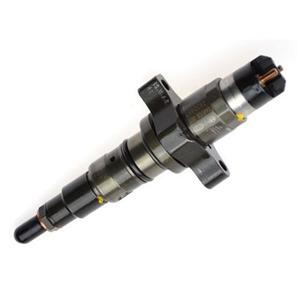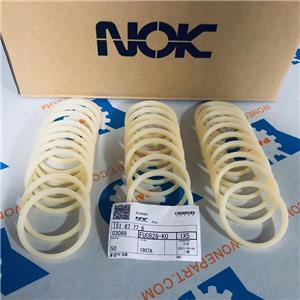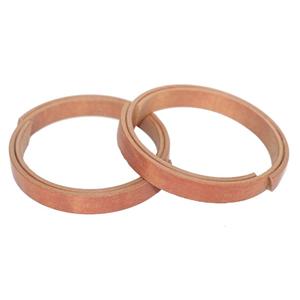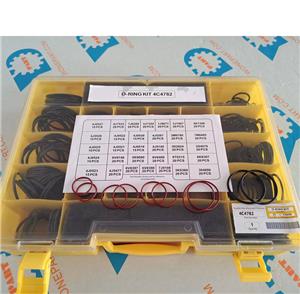The working principle of various electromagnetic reversing valves makes you a hydraulic master
The working principle of various electromagnetic reversing valves makes you a hydraulic master
Throttle
A throttle is a valve that controls the flow of fluid by changing the throttle cross section or throttle length.
The throttle valve does not have a negative flow feedback function, and cannot compensate for the speed instability caused by load changes. Generally, it is only used in situations where the load changes little or the speed stability is not high.
The external structure of the throttle valve is not different from that of the shut-off valve, except that the shapes of their opening and closing parts are different. The opening and closing parts of the throttle valve are mostly conical streamlined, which can adjust the flow rate and pressure by changing the cross-sectional area of the channel. Throttle valve is used to reduce the pressure of the medium under the condition of extreme pressure drop.
The flow rate of the medium between the throttle disc and the valve seat is so large that the surface of these parts is quickly damaged-the so-called cavitation phenomenon. In order to minimize the effects of cavitation, the valve disc is made of a cavitation resistant material (made of alloy steel) and is made into a streamlined cone with a tip angle of 140 to 180. This also allows the valve disc to have a larger opening height, which is generally not recommended.
Throttle
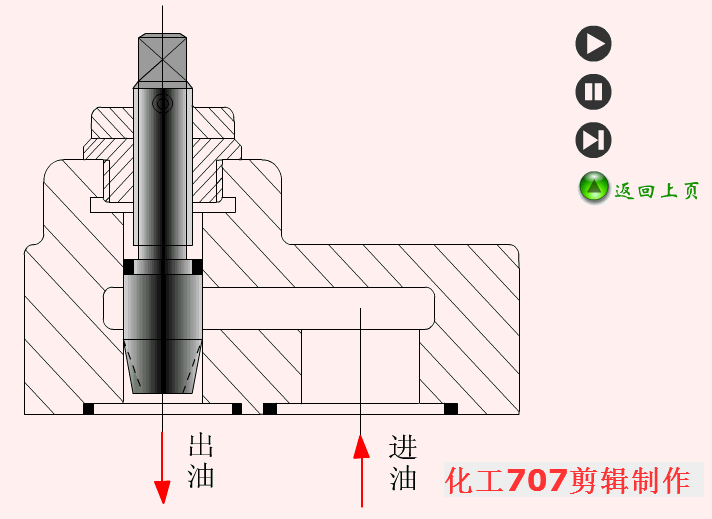
Throttle valve with large opening
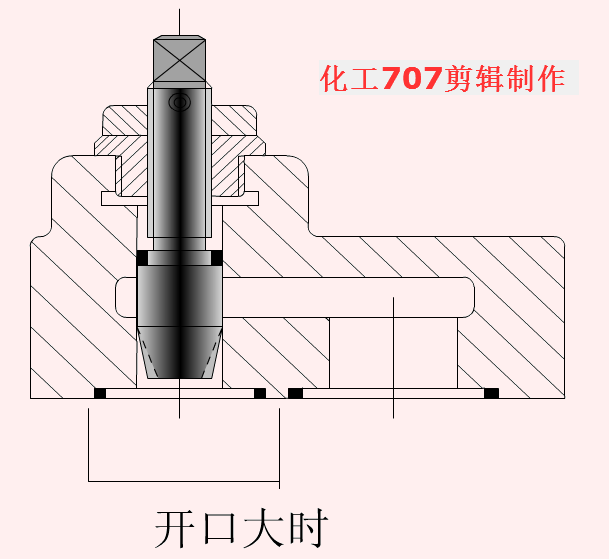
Throttle under small crevices.
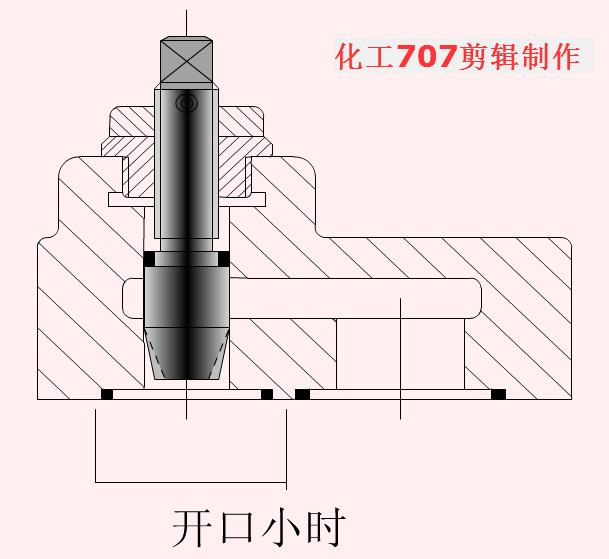
Throttle opening hours
Diverter manifold
Diverting and collecting valve is also called: synchronous valve, is an independent hydraulic device that integrates the functions of hydraulic diverting valve and collecting valve.
There are usually many methods to achieve synchronous movement, but the synchronous control hydraulic system using the diverting header-synchronous valve has many advantages such as simple structure, low cost, easy manufacturing, and high reliability. Therefore, the synchronous valve has been obtained Wide application.
When the diverter manifold P3 > P4
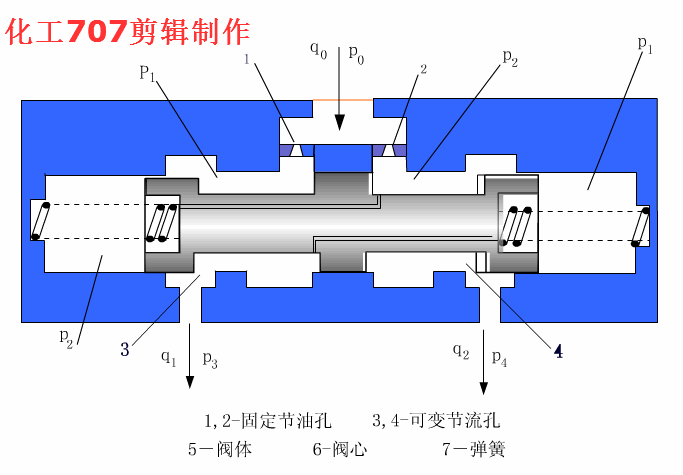
When the diverter manifold P3 = P4
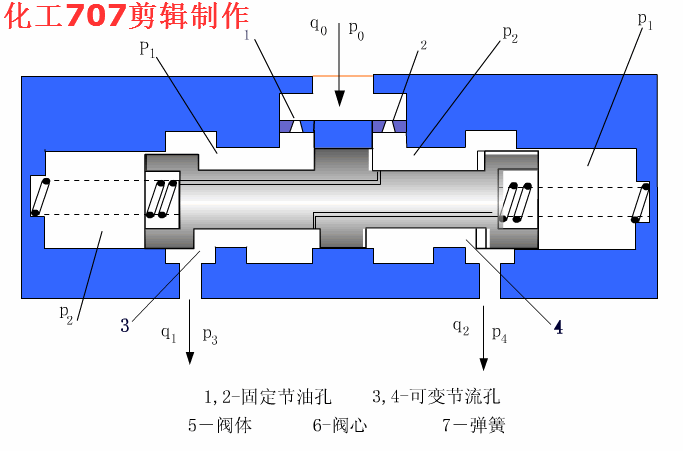
When the diverter manifold P3 <P4
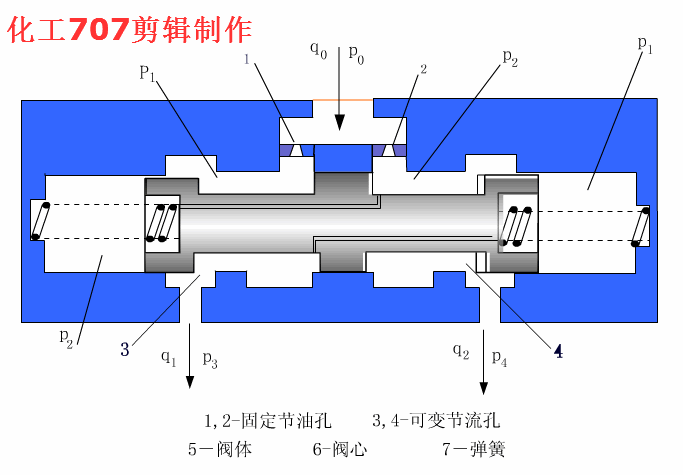
Sequence valve
A sequence valve is a valve that controls the operating sequence of the actuator based on the pressure of the circuits in a system with two or more branch circuits.
Sequence valve can realize different circuit functions, such as the function of relief valve, sequence valve and balance valve, according to different assembly structures.
If the opening and closing characteristics of the sequence valve are too poor, the primary pressure is too high when the flow rate is large, and the circuit efficiency is reduced. The opening and closing characteristics have a hysteresis loop. The opening pressure is lower than the closing pressure. Pay attention when the load flow changes.
Open the valve with too low pressure, the front leakage occurs when the re-pressure is lower than the set pressure, causing the actuator to malfunction. When the flow through the valve is much smaller than the rated flow, vibration or other instability occurs. Take measures on the circuit.
Sequence valve

Internal control and internal discharge sequence valve
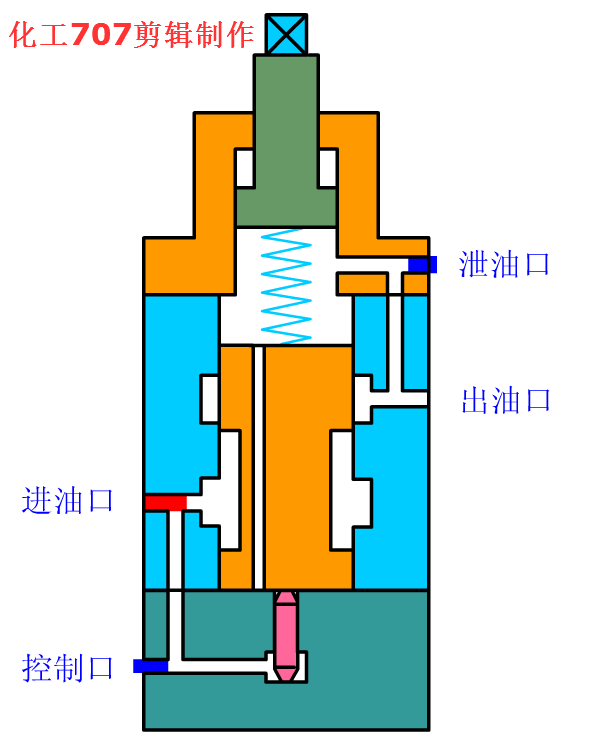
Internal control and drain type sequence valve
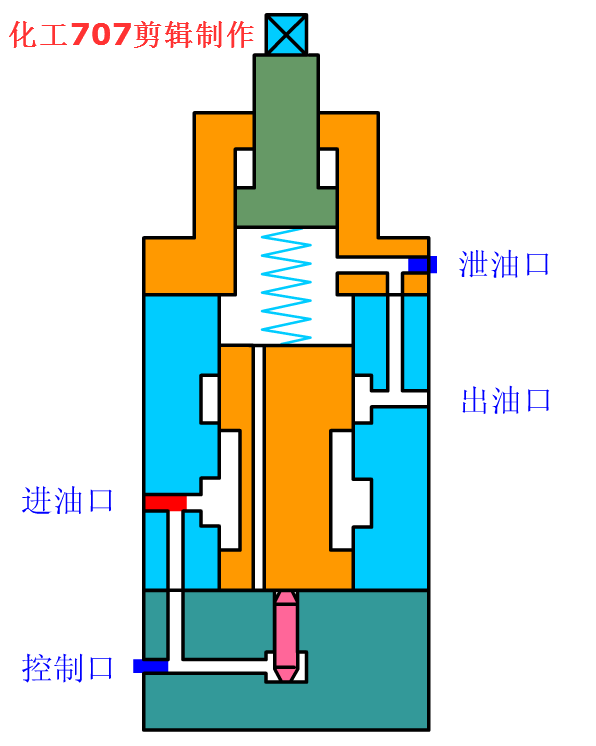
Externally controlled internal drain sequence valve
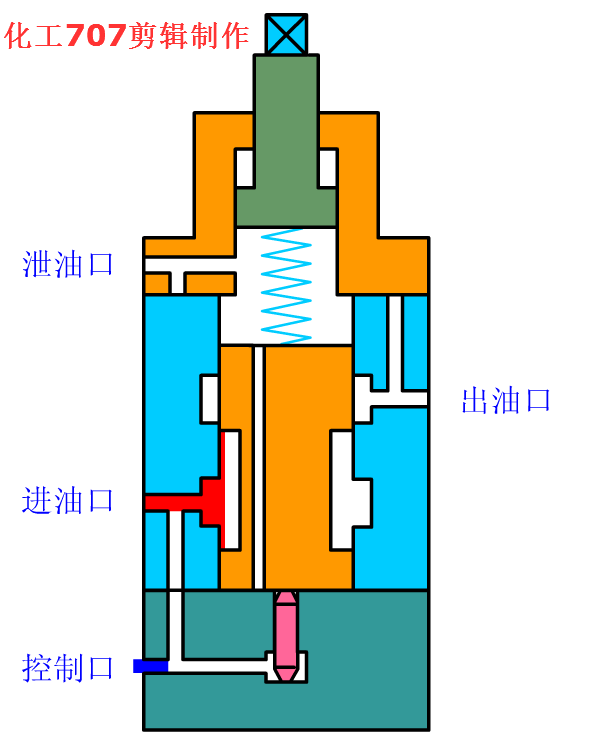
Externally-controlled leakage sequence valve
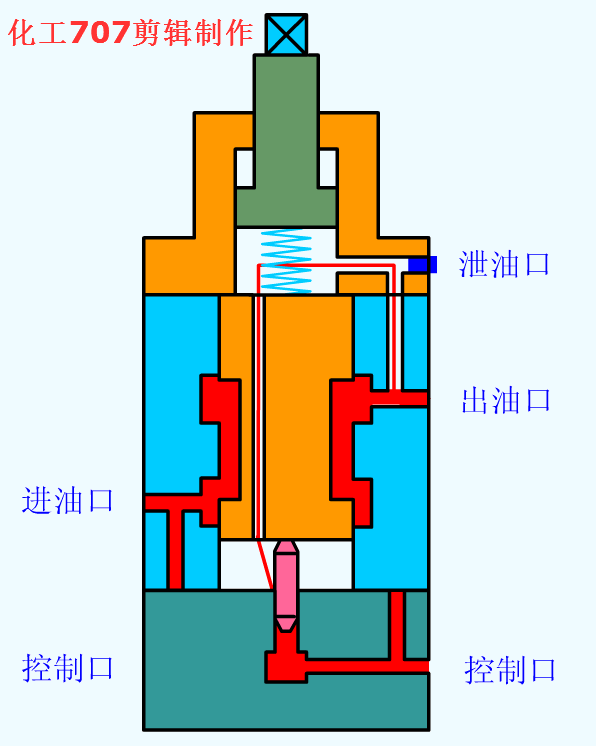
Control Valve
The speed regulating valve is a throttle valve with a fixed differential pressure reducing valve and a throttle valve in series, which is pressure-compensated.
The throttle valve is used to adjust the flow rate, and the fixed differential pressure reducing valve automatically compensates for the impact of load changes, so that the pressure difference before and after the throttle valve is a fixed value, eliminating the impact of load changes on the flow.
The pressure before and after the throttle valve is introduced to the right and left ends of the pressure reducing valve spool. When the load pressure increases, the hydraulic pressure acting on the left end of the pressure reducing spool increases, the valve core moves to the right, and the pressure reducing port As the pressure increases, the pressure drop decreases, so that the pressure difference (p2-p3) of the throttle valve remains unchanged; and vice versa. In this way, the flow of the speed regulating valve is constant (unaffected by the load).
The speed regulating valve can also be designed as a structure that first throttles and then decompresses.
When the pressure is reduced
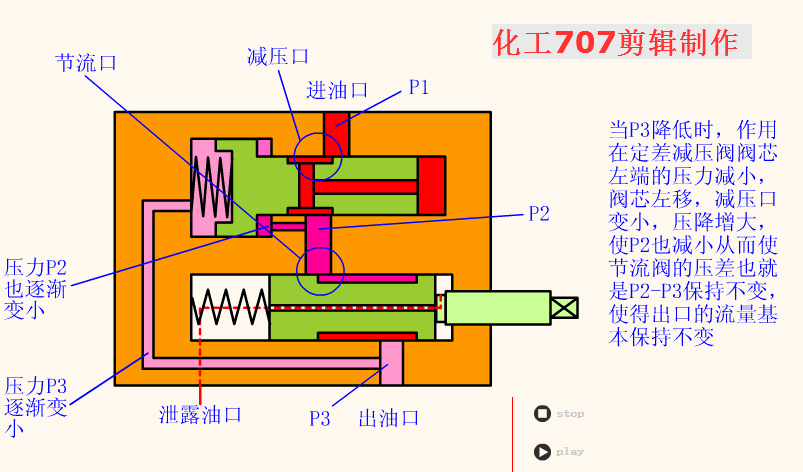
When the pressure of the governor increases
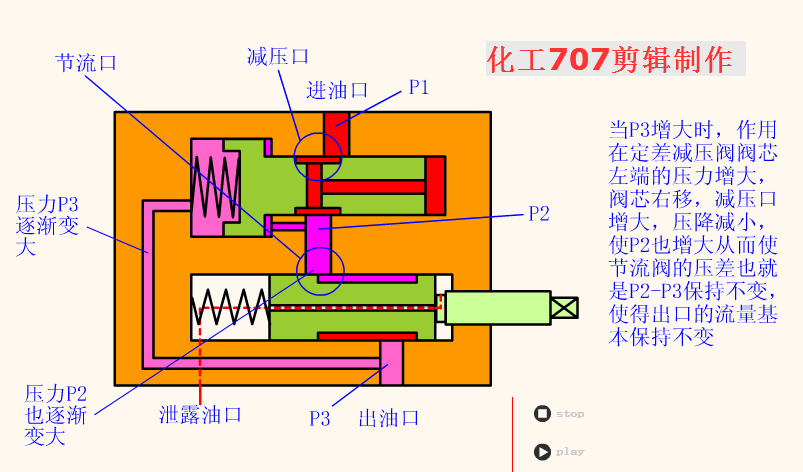 Relief valve
Relief valve
Relief valve is a hydraulic pressure control valve. It mainly plays the role of constant pressure relief, pressure stabilization, system unloading and safety protection in hydraulic equipment.
Constant pressure overflow effect: In the fixed pump throttling adjustment system, the fixed pump provides a constant flow. As system pressure increases, flow demand decreases. At this time, the relief valve is opened to allow excess flow to overflow to the fuel tank to ensure that the pressure at the inlet of the relief valve, that is, the pump outlet pressure is constant (the valve port often opens with pressure fluctuations).
Stabilizing effect: The relief valve is connected in series to the oil return path. The relief valve generates back pressure and the stability of moving parts increases.
System unloading function: The remote control port of the relief valve is connected in series with a small-flow solenoid valve. When the solenoid is energized, the remote control port of the relief valve passes through the fuel tank, and the hydraulic pump is unloaded at this time. The relief valve is now used as a relief valve.
Safety protection function: When the system works normally, the valve is closed. Only when the load exceeds the specified limit (the system pressure exceeds the set pressure), the overflow is turned on and the overload protection is performed to prevent the system pressure from increasing (usually the set pressure of the relief valve is 10% to 20% higher than the maximum working pressure of the system ).
The main requirements for the relief valve: large pressure adjustment range, small pressure deviation, small pressure swing, sensitive action, large overload capacity and low noise.
Pilot operated relief valve
The pilot-operated relief valve, which acts on the main spool and the pressure-measuring surface of the pilot spool, consists of a pilot and a main valve.
During operation, hydraulic pressure acts on the pressure measuring surfaces of the main spool and the pilot spool simultaneously.
When the pilot valve 1 is not opened, the oil does not flow in the valve cavity, and the pressure acting on the main spool 6 is equal to the upper and lower directions. The valve core is in the lowermost position under the action of the resultant force, and the valve port is closed.
When the oil inlet pressure is increased to make the pilot valve open, the liquid flow flows back to the fuel tank through the damping hole 5 and the pilot valve 1 on the main valve core. Due to the damping effect of the damping hole, the hydraulic pressure in the upper and lower directions of the main spool 6 is not equal. The main spool moves up under the pressure difference, opens the valve port, realizes overflow, and maintains the pressure basically stable. . By adjusting the pressure regulating spring 9 of the pilot valve, the overflow pressure can be adjusted.
Pilot operated relief valve
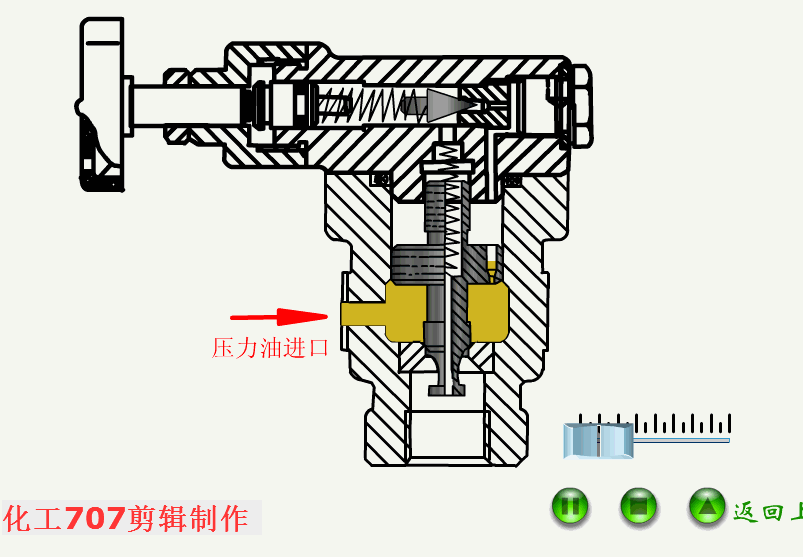 Relief valve overflow
Relief valve overflow
When the oil pressure is not high
When the inlet pressure increases
Low pressure relief valve
When the pressure is not high
When the pressure rises
Pressure reducing valve
The pressure reducing valve is a valve that adjusts the inlet pressure to a certain required outlet pressure and relies on the energy of the medium to automatically maintain a stable outlet pressure.
From the point of view of fluid mechanics, the pressure reducing valve is a throttle element whose local resistance can be changed, that is, by changing the throttle area, the flow velocity and the kinetic energy of the fluid are changed, resulting in different pressure losses, thereby achieving the purpose of pressure reduction. Then rely on the adjustment of the control and adjustment system to balance the fluctuation of the pressure behind the valve with the spring force, so that the pressure behind the valve remains constant within a certain error range.
Cartridge valve
Cartridge valve is different from what we call ordinary hydraulic control valve. Its flow rate can reach 1000L / min and its diameter can reach 200 ~ 250mm.
The spool is simple in structure, sensitive in action, and good in tightness. Its function is relatively single. It mainly realizes the on or off of the liquid circuit. Only when it is used in combination with the ordinary hydraulic control valve can it control the oil direction, pressure and flow of the system.
If you have any hydraulic valve questions, pls feel free to contact us info@wonepart.com, we will support you.
